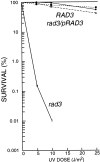Rous-Whipple Award Lecture. Nucleotide excision repair and cancer predisposition: A journey from man to yeast to mice
- PMID: 10980107
- PMCID: PMC1885695
- DOI: 10.1016/s0002-9440(10)64581-6
Rous-Whipple Award Lecture. Nucleotide excision repair and cancer predisposition: A journey from man to yeast to mice
Figures








Similar articles
-
Rous-Whipple Award lecture. The biology and pathology of lymphocyte Fc receptors.Am J Pathol. 1998 Mar;152(3):631-9. Am J Pathol. 1998. PMID: 9502402 Free PMC article. Review. No abstract available.
-
Presentation of the first Rous-Whipple award to Jacob Furth.Am J Pathol. 1975 Nov;81(2):263-6. Am J Pathol. 1975. PMID: 1103630 Free PMC article. No abstract available.
-
Re: markers of DNA repair and susceptibility to cancer in humans: an epidemiologic review.J Natl Cancer Inst. 2000 Sep 20;92(18):1536-7. doi: 10.1093/jnci/92.18.1536. J Natl Cancer Inst. 2000. PMID: 10995815 No abstract available.
-
Rous-Whipple Award Lecture. Viruses and diseases of the twenty-first century.Am J Pathol. 1993 Nov;143(5):1241-9. Am J Pathol. 1993. PMID: 8238240 Free PMC article. No abstract available.
-
Spontaneous DNA damage, genome instability, and cancer--when DNA replication escapes control.Cell. 2001 Feb 9;104(3):329-32. doi: 10.1016/s0092-8674(01)00220-3. Cell. 2001. PMID: 11239390 Review. No abstract available.
Cited by
-
XPC silencing in normal human keratinocytes triggers metabolic alterations that drive the formation of squamous cell carcinomas.J Clin Invest. 2011 Jan;121(1):195-211. doi: 10.1172/JCI40087. Epub 2010 Dec 1. J Clin Invest. 2011. PMID: 21123941 Free PMC article.
-
Sod2 haploinsufficiency does not accelerate aging of telomere dysfunctional mice.Aging (Albany NY). 2009 Mar 5;1(3):303-15. doi: 10.18632/aging.100030. Aging (Albany NY). 2009. PMID: 20195488 Free PMC article.
-
Base excision repair activities differ in human lung cancer cells and corresponding normal controls.Anticancer Res. 2010 Dec;30(12):4963-71. Anticancer Res. 2010. PMID: 21187477 Free PMC article.
-
N4-acetylcytidine and other RNA modifications in epitranscriptome: insight into DNA repair and cancer development.Epigenomics. 2025 Apr;17(6):411-422. doi: 10.1080/17501911.2025.2473308. Epub 2025 Mar 5. Epigenomics. 2025. PMID: 40040517 Free PMC article. Review.
References
-
- Friedberg EC, Walker GC, Siede W: DNA Repair and Mutagenesis. 1995. DC, American Society for Microbiology, Washington
-
- Cleaver JE: Defective repair replication of DNA in xeroderma pigmentosum. Nature 1968, 218:652-656 - PubMed
-
- Rasmussen RE, Painter RB: Evidence for repair of ultra-violet damaged deoxyribonucleic acid in cultured mammalian cells. Nature 1964, 1360–1362 - PubMed
-
- De Weerd-Kastelein EA, Keijzer W, Bootsma D: Genetic heterogeneity of xeroderma pigmentosum demonstrated by somatic cell hybridization. Nat New Biol 1972, 238:80-83 - PubMed
Publication types
MeSH terms
Substances
LinkOut - more resources
Full Text Sources
Molecular Biology Databases

